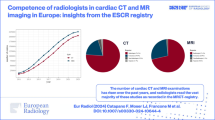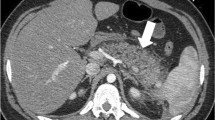Abstract
This work was conducted to determine whether non-contrast-enhanced CT (NECT) of patients with suspected acute aortic syndrome (AAS) can identify patients with a very low likelihood of a positive diagnosis. In the derivation phase, patients who received both NECT and contrast-enhanced CT angiography (CTA) for suspected AAS were identified. Two readers blinded to CTA results analyzed NECTs from AAS positive and negative cases, recording maximal aortic diameters and qualitative findings of aortic disease. Logistic regression analysis was performed to identify independent positive predictors for AAS; those predictors were then used to create a decision rule. For the validation phase, NECTs from patients evaluated for AAS at a second institution were reviewed by two independent readers who recorded the presence of decision rule predictors while blinded to CTA results. In the derivation phase, 34 CTA positive and 83 CTA negative cases were reviewed. Measurements of aortic diameter alone achieved mean sensitivity and specificity of 82 % and of 83 %, respectively. Logistic regression identified aortic diameter, displaced calcifications, high attenuation aortic wall and abnormal aortic contour as independent predictors of AAS. The decision rule incorporating these findings achieved higher mean sensitivity (93 %), negative predictive value (96 %), and moderate reader agreement (kappa = 0.59). For the validation phase, application of the decision rule to 35 AAS positive and 45 AAS negative cases at the second institution yielded sensitivity of 100 % and specificity of 74 % for both readers. NECT can identify patients with a very low likelihood of AAS and potentially mitigate the urgency of performing CTA.


Similar content being viewed by others
References
Vilacosta I, Roman JA (2001) Acute aortic syndrome. Heart 85(4):365–368
Tsai TT, Nienaber CA, Eagle KA (2005) Acute aortic syndromes. Circulation 112(24):3802–3813. doi:10.1161/CIRCULATIONAHA.105.534198
Criado FJ (2011) Aortic dissection: a 250-year perspective. Tex Heart Inst J 38(6):694–700
Hardie AD, Wineman RW, Nandalur KR (2009) The natural history of acute non-traumatic aortic diseases. Emerg Radiol 16(2):87–95
Hagan PG, Nienaber CA, Isselbacher EM, Bruckman D et al (2000) The International Registry of Acute Aortic Dissection (IRAD): new insights into an old disease. JAMA 283(7):897–903
Shiga T, Wajima Z, Apfel CC, Inoue T, Ohe Y (2006) Diagnostic accuracy of transesophageal echocardiography, helical computed tomography, and magnetic resonance imaging for suspected thoracic aortic dissection: systematic review and meta-analysis. Arch Intern Med 166(13):1350–1356
Yeow TN, Raju VM, Venkatanarasimha N, Fox BM (2011) Pictorial review: computed tomography features of cardiovascular emergencies and associated imminent decompensation. Emerg Radiol 18:127–138
Ledbetter S, Stuk JL, Kaufman JA (1999) Helical (spiral) CT in the evaluation of emergent thoracic aortic syndromes. Traumatic aortic rupture, aortic aneurysm, aortic dissection, intramural hematoma, and penetrating atherosclerotic ulcer. Radiol Clin North Am 37(3):575–89, 1999 May
Freeman LA, Young PM, Foley TA, Williamson EE, Bruce CJ, Greason KL (2013) CT and MRI assessment of the aortic root and ascending aorta. AJR Am J Roentgenol 200(6):W581–592
Bettmann MA (2004) Frequently asked questions: iodinated contrast agents. Radiographics Oct 24(Suppl 1):S3–10
Ellis JH, Cohan RH (2009) Reducing the risk of contrast-induced nephropathy: a perspective on the controversies. AJR Am J Roentgenol 192(6):1544–1549
Haarh M Random sequence generator. Available at: http://www.random.org/sequences. Accessed 26 July 2012
Aronberg DJ, Glazer HS, Madsen K, Sagel SS (1984) Normal thoracic aortic diameters by computed tomography. J Comput Assist Tomogr 8(2):247–250
Mao SS, Ahmadi N, Shah B, Beckmann D, Chen A, Ngo L, Flores FR, Gao YL, Budoff MJ (2008) Normal thoracic aorta diameter on cardiac computed tomography in healthy asymptomatic adults: impact of age and gender. Acad Radiol 15(7):827–834. doi:10.1016/j.acra.2008.02.001
Landis JR, Koch GG (1977) The measurement of observer agreement for categorical data. Biometrics 33(1):159–174
Lovy AJ, Rosenblum JK, Levsky JM, Godelman A, Zalta B, Jain VR, Haramati LB (2013) Acute aortic syndromes: a second look at dual-phase CT. AJR Am J Roentgenol 200(4):805–811. doi:10.2214/AJR.12.8797
Schertler T, Glücker T, Wildermuth S et al (2005) Comparison of retrospectively ECG-gated and nongated MDCTof the chest in anemergency setting regarding workflow, image quality, and diagnostic certainty. Emerg Radiol 12:19–29
Wolak A, Gransar H, Thomson LE, Friedman JD, Hachamovitch R, Gutstein A, Shaw LJ, Polk D, Wong ND, Saouaf R, Hayes SW, Rozanski A, Slomka PJ, Germano G, Berman DS (2008) Aortic size assessment by noncontrast cardiac computed tomography: normal limits by age, gender, and body surface area. JACC Cardiovasc Imaging 1(2):200–209. doi:10.1016/j.jcmg.2007.11.005
Klompas M (2002) Does this patient have an acute thoracic aortic dissection? JAMA 287(17):2262–2272
Rogers AM, Hermann LK, Booher AM, Nienaber CA, Williams DM, Kazerooni EA, Froehlich JB, O'Gara PT, Montgomery DG, Cooper JV, Harris KM, Hutchison S, Evangelista A, Isselbacher EM, Eagle KA (2011) Sensitivity of the aortic dissection detection risk score, a novel guideline-based tool for identification of acute aortic dissection at initial presentation: results from the international registry of acute aortic dissection. Circulation 123(20):2213–18
Johnson HA (1991) Diminishing returns on the road to diagnostic certainty. JAMA 265:2229–2231
Egglin TK, Feinstein AR (1996) Context bias. A problem in diagnostic radiology. JAMA 276(21):1752–1755
Acknowledgements
The authors thank Andrew Lovy, MD, whose medical student thesis work formed the basis of the validation set.
Conflict of interest
The authors declare that they have no conflict of interest.
Author information
Authors and Affiliations
Corresponding author
Rights and permissions
About this article
Cite this article
Vantine, P.R., Rosenblum, J.K., Schaeffer, W.G. et al. Can non-contrast-enhanced CT (NECT) triage patients suspected of having non-traumatic acute aortic syndromes (AAS)?. Emerg Radiol 22, 19–24 (2015). https://doi.org/10.1007/s10140-014-1239-8
Received:
Accepted:
Published:
Issue Date:
DOI: https://doi.org/10.1007/s10140-014-1239-8




